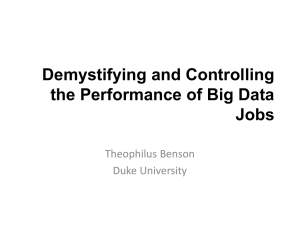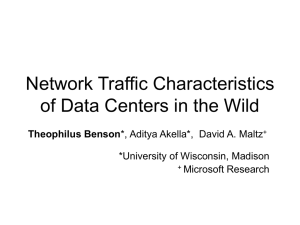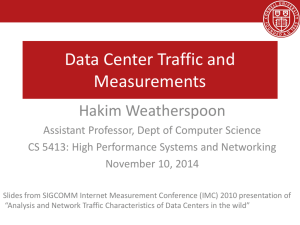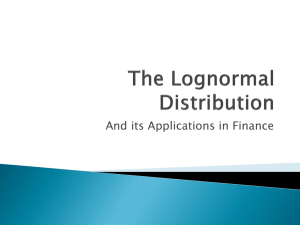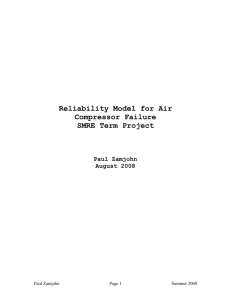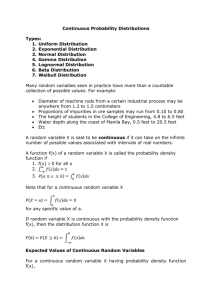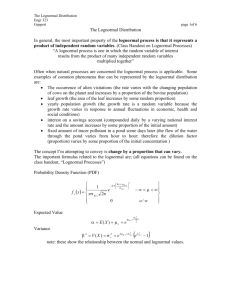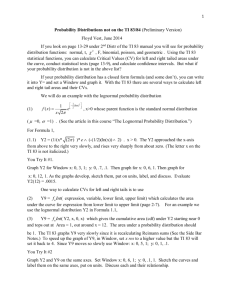Network Traffic Characteristics of Data Centers in the Wild
advertisement
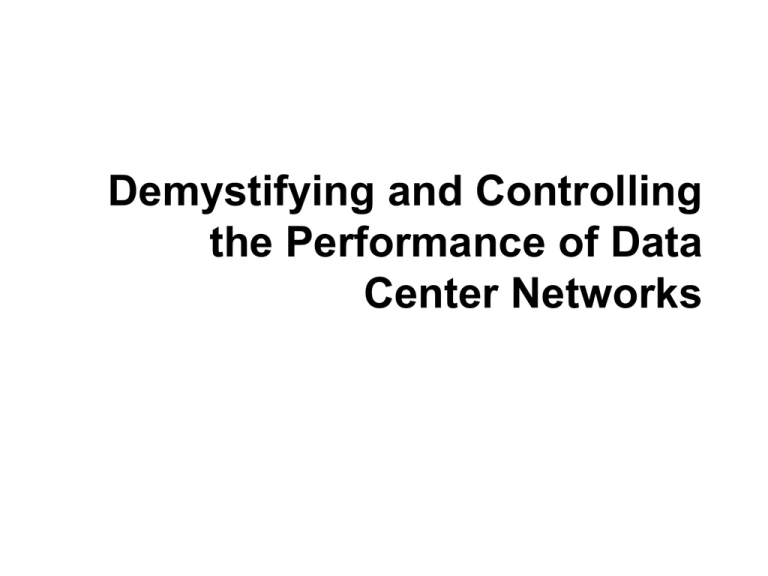
Demystifying and Controlling the Performance of Data Center Networks Why are Data Centers Important? • Internal users – Line-of-Business apps – Production test beds • External users – Web portals – Web services – Multimedia applications – Chat/IM Why are Data Centers Important? • Poor performance loss of revenue • Understanding traffic is crucial • Traffic engineering is crucial Road Map • Understanding Data center traffic • Improving network level performance • Ongoing work Canonical Data Center Architecture Core (L3) Aggregation (L2) Edge (L2) Top-of-Rack Application servers Dataset: Data Centers Studied DC Role DC Name Location Number Devices Universities EDU1 US-Mid 22 EDU2 US-Mid 36 EDU3 US-Mid 11 Private Enterprise PRV1 US-Mid 97 PRV2 US-West 100 Commercial Clouds CLD1 US-West 562 CLD2 US-West 763 CLD3 US-East 612 External users CLD4 S. America 427 Clouds Large Globally diverse CLD5 S. America 427 10 data centers 3 classes Universities Private enterprise Clouds Internal users Univ/priv Small Local to campus Dataset: Collection • SNMP – – – – DC Name SNMP Poll SNMP MIBs Bytes-in/bytes-out/discards EDU1 Yes > 10 Days EDU2 Yes Averaged over 5 mins • Packet Traces – Cisco port span – 12 hours • Topology – Cisco Discovery Protocol Packet Traces Topology Yes Yes Yes Yes EDU3 Yes Yes Yes PRV1 Yes Yes Yes PRV2 Yes Yes Yes CLD1 Yes No No CLD2 Yes No No CLD3 Yes No No CLD4 Yes No No CLD5 Yes No No Canonical Data Center Architecture Core (L3) Aggregation (L2) Edge (L2) Top-of-Rack Application servers Packet Sniffers Analyzing Packet Traces • Transmission patterns of the applications • Properties of packet crucial for – Understanding effectiveness of techniques Routing must react quickly to overcome bursts • ON-OFF traffic at edges – Binned in 15 and 100 m. secs – We observe that ON-OFF persists 9 Data-Center Traffic is Bursty • Understanding arrival process – Range of acceptable models • What is the arrival process? – Heavy-tail for the 3 distributions Data Center Off Period Dist ON periods Dist Inter-arrival Dist Prv2_1 Lognormal Lognormal Lognormal Prv2_2 Lognormal Lognormal Lognormal Prv2_3 Lognormal Lognormal Lognormal Need new models to generate traffic • ON, OFF times, Inter-arrival, – Lognormal across all data centers Prv2_4 Lognormal Lognormal Lognormal EDU1 Lognormal Weibull Weibull EDU2 Lognormal Weibull Weibull EDU3 Lognormal Weibull Weibull • Different from Pareto of WAN – Need new models 10 Canonical Data Center Architecture Core (L3) Aggregation (L2) Edge (L2) Top-of-Rack Application servers Intra-Rack Versus Extra-Rack • Quantify amount of traffic using interconnect – Perspective for interconnect analysis Extra-Rack Edge Intra-Rack Application servers Extra-Rack = Sum of Uplinks Intra-Rack = Sum of Server Links – Extra-Rack Intra-Rack Versus Extra-Rack Results 100 90 80 70 60 50 40 30 20 10 0 Extra-Rack Inter-Rack EDU1 EDU2 EDU3 PRV1 PRV2 CLD1 CLD2 CLD3 CLD4 CLD5 • Clouds: most traffic stays within a rack (75%) – Colocation of apps and dependent components • Other DCs: > 50% leaves the rack – Un-optimized placement Extra-Rack Traffic on DC Interconnect • Utilization: core > agg > edge – Aggregation of many unto few • Tail of core utilization differs – Hot-spots links with > 70% util – Prevalence of hot-spots differs across data centers Persistence of Core Hot-Spots • Low persistence: PRV2, EDU1, EDU2, EDU3, CLD1, CLD3 • High persistence/low prevalence: PRV1, CLD2 – 2-8% are hotspots > 50% • High persistence/high prevalence: CLD4, CLD5 – 15% are hotspots > 50% Prevalence of Core Hot-Spots 0.6% 0.0% 6.0% Smart routing can better utilize core and avoid hotspots 0.0% 24.0% 0.0% 0 10 20 30 Time (in Hours) 40 50 • Low persistence: very few concurrent hotspots • High persistence: few concurrent hotspots • High prevalence: < 25% are hotspots at any time Insights Gained • 75% of traffic stays within a rack (Clouds) – Applications are not uniformly placed • Traffic is bursty at the edge • At most 25% of core links highly utilized – Effective routing algorithm to reduce utilization – Load balance across paths and migrate VMs Road Map • Understanding Data center traffic • Improving network level performance • Ongoing work Options for TE in Data Centers? • Current supported techniques – Equal Cost MultiPath (ECMP) – Spanning Tree Protocol (STP) • Proposed – Fat-Tree, VL2 • Other existing WAN techniques – COPE,…, OSPF link tuning How do we evaluate TE? • Simulator – Input: Traffic matrix, topology, traffic engineering – Output: Link utilization • Optimal TE – Route traffic using knowledge of future TM • Data center traces – Cloud data center (CLD) • Map-reduce app • ~1500 servers – University data center (UNV) • 3-Tier Web apps • ~500 servers Draw Backs of Existing TE • STP does not use multiple path – 40% worst than optimal • ECMP does not adapt to burstiness – 15% worst than optimal Design Goals for Ideal TE Design Requirements for TE • Calculate paths & reconfigure network – Use all network paths – Use global view • Avoid local optimals – Must react quickly • React to burstiness • How predictable is traffic? …. Is Data Center Traffic Predictable? 27% 99% • YES! 27% or more of traffic matrix is predictable • Manage predictable traffic more intelligently How Long is Traffic Predictable? 1.5 – 5.0 1.6 - 2.5 • Different patterns of predictability • 1 second of historical data able to predict future MicroTE MicroTE: Architecture Monitoring Component Routing Component Network Controller • Global view: – Created by network controller • React to predictable traffic: – Routing component tracks demand history • All N/W paths: – Routing component creates routes using all paths Architectural Questions • Efficiently gather network state? • Determine predictable traffic? • Generate and calculate new routes? • Install network state? Architectural Questions • Efficiently gather network state? • Determine predictable traffic? • Generate and calculate new routes? • Install network state? Monitoring Component • Efficiently gather TM • Only one server per ToR monitors traffic • Transfer changed portion of TM • Compress data • Tracking predictability – Calculate EWMA over TM (every second) • Empirically derived alpha of 0.2 • Use time-bins of 0.1 seconds Routing Component New Global View Determine predictable ToRs Calculate network routes for predictable traffic Set ECMP for unpredictable traffic Install routes Routing Predictable Traffic • LP formulation – Constraints • Flow conservation • Capacity constraint • Use K-equal length paths – Objective • Minimize link utilization • Bin-packing heuristic – Sort flows in decreasing order – Place on link with greatest capacity Implementation • Changes to data center – Switch • Install OpenFlow firmware – End hosts • Add kernel module • New component – Network controller • C++ NOX modules Evaluation Evaluation: Motivating Questions • How does MicroTE Compare to Optimal? • How does MicroTE perform under varying levels of predictability? • How does MicroTE scale to large DCN? • What overheard does MicroTE impose? Evaluation: Motivating Questions • How does MicroTE Compare to Optimal? • How does MicroTE perform under varying levels of predictability? • How does MicroTE scale to large DCN? • What overheard does MicroTE impose? How do we evaluate TE? • Simulator – Input: Traffic matrix, topology, traffic engineering – Output: Link utilization • Optimal TE – Route traffic using knowledge of future TM • Data center traces – Cloud data center (CLD) • Map-reduce app • ~1500 servers – University data center (UNV) • 3-Tier Web apps • ~400 servers Performing Under Realistic Traffic • Significantly outperforms ECMP • Slightly worse than optimal (1%-5%) • Bin-packing and LP of comparable performance Performance Versus Predictability 100 MLU 80 60 40 20 0 Time (in Secs) ECMP MicroTE Optimal • Low predictability performance is similar to ECMP Performance Versus Predictability 120 100 MLU 80 60 40 20 0 Time (in Secs) ECMP MicroTE Optimal • Low predictability performance is similar to ECMP • High predictability performance is comparable to Optimal • MicroTE adjusts according to predictability Conclusion • Study existing TE – Found them lacking (15-40%) • Study data center traffic – Discovered traffic predictability (27% for 2 secs) • Developed guidelines for ideal TE • Designed and implemented MicroTE – Brings state of the art within 1-5% of Ideal – Efficiently scales to large DC (16K servers) Road Map • Understanding Data center traffic • Improving network level performance • Ongoing work Looking forward • Stop treating the network as a carrier of bits • Bits in the network have a meaning – Applications know this meaning. • Can applications control networks? – E.g Map-reduce • Scheduler performs network aware task placement and flow placement
